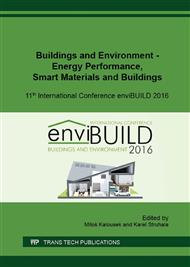p.198
p.206
p.213
p.221
p.231
p.239
p.247
p.255
p.263
Determination of Capillary Conductivity Coefficient by Using Electromagnetic Microwave Radiation
Abstract:
Moisture in building structures affects negatively construction material physical properties, particularly thermally insulation properties. The porous structure of most building materials distinguishes by the ability to absorb water in liquid and gaseous state into its internal cavities, to fill the accumulative space of pores, to transport moisture and to re-transmit to the surroundings. The moisture characteristics of building materials are the base for evaluation of building structure thermal insulation properties. The moisture spreading via capillary conduction is the most significant material parameter of a moisture appraisal. However, it is necessary to incorporate also spreading the liquid phase into the moisture appraisal for certain structure material compositions. The article deals with determination of capillary conductivity coefficient by using electromagnetic microwave radiation. The radiation passed through a wet sample is detected and then the value of capillary conductivity coefficient is determined. The coefficient of capillary conductivity is property dependent on several physical parameters, but primarily on the moisture.
Info:
Periodical:
Pages:
231-238
Citation:
Online since:
December 2016
Authors:
Price:
Сopyright:
© 2017 Trans Tech Publications Ltd. All Rights Reserved
Share:
Citation:


